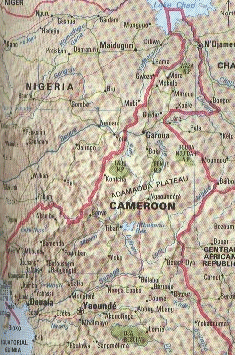

|



 Cameroon
Cameroon

|
Directory Information
|
Cameroon, a republic in western Africa, is bounded
on the north and east by Chad and the Central Africa
Republic, on the south by Congo, Gabon, and
Equatorial Guinea, and on the west by the Gulf of
Guinea and Nigeria. Lake Chad links it to Niger.
Population (1990 est.) 11,834,000; area 475,442 sq.km.
The official languages are English and French, but
there are more than 200 Cameroonian languages.
History
Before the coming of the written
word, people passed on stories, messages, and other
by word of mouth. The drum was also
widely used. Oral tradition will play a key role for a
long time to come. The Regional Centre for the
Collection of Oral Traditions and Literatures collects
and stores much "knowledge" from the "old wise
people." It is said that "when an old man dies, it is a
library buming."
After the partition of Africa in 1884, the Germans
introduced their language as the lingua franca in
Cameroon. There is now little German spoken except
by the old men who still pride themselves in it. In 1971, Max Dippold published a bibliography of documents
in the German language in Cameroon that lists 6,216
titles. Most of these are in the National Archives in
Yaounde. But a student using documents in the
German language still has to go to Germany. The
Germans left fortresses and archives in Cameroon, but
no libraries. After World War 1, the French and British
ruled parts of Cameroon. The French colonial administrators established bibliotheques de brousse (rural libraries) but these libraries served only as reading centers
for officers who had to work far from the urban
centers. There is no evidence in the French-speaking
part of Cameroon of any deliberate aim to open
libraries for the people.
In the English-speaking part of the country,
following the British tradition, all secondary schools
had libraries. Some of these have grown but have not
reached the dimensions of real school libraries. Many
people still take pride in saying, "I was the school
librarian." In fact, these people were students in
charge ofthe libraries. Even though the libraries did
not receive many books, and although the growth has
been rather slow, all the secondary schools, especially
those run by missionary bodies, have libraries. It
would be an overstatement to say that all secondary
schools had libraries in English-speaking Cameron.
Before independence (1961), only the government and
missionary bodies ran secondary schools. Later irianv
private secondary schools were opened, most of them
with libraries.
Sonic public libraries existed in the larger towns,
although most of them in the capital city were opened
around 1960 by foreign bodies. Those opened by
foreign embassies are called cultural centers. The few
public libraries that existed in the 1960s were those of
Garona and Douala in French-speaking Cameron and
Bainenda and Limbe (formerly Victoria) in English-
speaking Cameron. None of these libraries had more
than a few hundred volumes, in poor condition.
Urban centers had a great influence on people after about
1968 because of the availability of schooling and
greater opportunities for jobs. A major hurdle in the
development of public libraries was the lack of trained
librarians.
National Library Service
The Cameron
National Library was established in 1966. It is attached
to the Ministry of Information and Culture. It has
three sections: Acquisition and Legal De osit, Classification and Cataloguing, and National Bibliography.
By 1990 it had 20,000 books, 130 periodicals and 150
reports (64,000 vols by 1998). The book collection grew because of French
government donations in the 1980s. The National
Library is now called Service du Livre et des Biblioteques (Book and Library Services). The National
Library is supposed to produce the National Bibliography, but no volumes had been issued by 1990. The
National Archives was also attached to the Ministry of
Information arid Culture.
Academic Libraries
The largest academic library is that of the University of Yaounde. It was
established in 1966 when the University (founded in
1962-63) moved to its present site. It brought togethe a number of small book collections scattered
over the whole campus. It did not comprise a large
collection; in 1973 it totaled 52,000 books, 620 serials,
and small collections of slides, tapes, and microfilms.
By 1990 the book collection had increased to 93,000
arid the serials to about 900.
Efforts were made to increase reading facilties for
the students at the University of Yaounde. Planning
to r a new building started in 1975 and construction
began in 1983. It was planned as a modern library.
with space for at least 500,000 books, facilities for
about 600 readers, and modern equipment, including
an IBM 4331 computer acquired in 1985.
Other academic libraries include those of the
Other academic libraries include those of the
School of Journalism, opened in 1971 to train journalists
for work in central Africa. By 1990 it held almost
5,000 books, 130 journal titles, and 400 reports. The
Polytechnic School, opened in 1971 to train engineers
mainly in road construction, building construction,
architecture, and electrical engineering, had about 90
sitting places, almost 6,000 books, and 70 current
serials in 1990. The Advanced Teacher College,
opened in 1961 and the oldest institute in the University
of Yaotinde, held by 1990 nearly 30,000 books arid
180 serial titles. The Medical School, opened in 1969,
held more than 25,000 books, 250 journal titles, and
440 reports, representing the largest collection outside
the main University Library. The School of International
Relations, opened in 1972, has about 12,000
books, 200 serials, and 130 reports, including United
Nations documents. There are libraries at the University
Centers at Buea, Douala, Dschang, and Ngaoundere.
Sources:



|